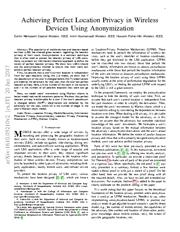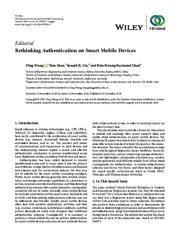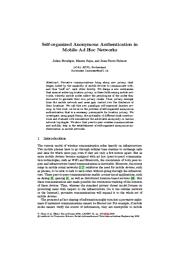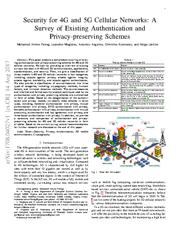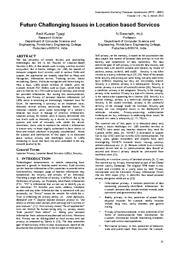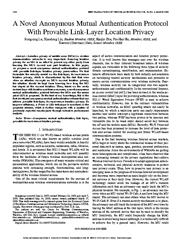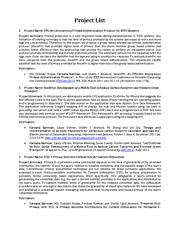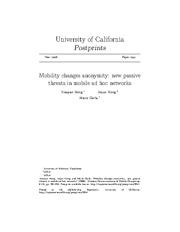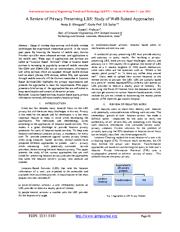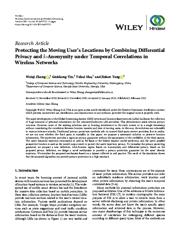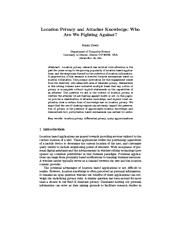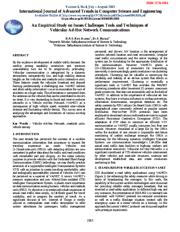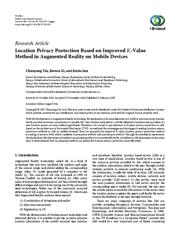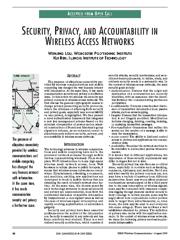A copy of this work was available on the public web and has been preserved in the Wayback Machine. The capture dates from 2020; you can also visit the original URL.
The file type is application/pdf.
Filters
Achieving Perfect Location Privacy in Wireless Devices Using Anonymization
[article]
2017
arXiv
pre-print
We show how LBS's should use the anonymization method to ensure that their users can achieve perfect location privacy. ...
Anonymization is a common technique that is often used to protect the location privacy of LBS users. ...
We show that wireless devices can achieve provable perfect location privacy by using the anonymization method in the suggested way. ...
arXiv:1610.05210v2
fatcat:glxshwrvw5hjvpwnysjgicyche
Achieving Perfect Location Privacy in Wireless Devices Using Anonymization
2017
IEEE Transactions on Information Forensics and Security
We show that mobile devices can achieve provable perfect location privacy by using the anonymization method in the suggested way. ...
By using the same notion of perfect location privacy we show the feasibility of achieving perfect location privacy using Markov chain. ...
P = (p 1 , p 2 , · · · , p n ) be known to the adversary then, we have perfect location privacy for all the users, e.g. for the first user we have, ∀k ∈ N, lim n→∞ I X 1 (k); Y (m) = 0. ...
doi:10.1109/tifs.2017.2713341
fatcat:xxeqb5avqrba7jl5ul7usm3jbq
Rethinking Authentication on Smart Mobile Devices
2018
Wireless Communications and Mobile Computing
The launch of this special issue was in 4 Wireless Communications and Mobile Computing part supported by the National Key Research and Development Plan under Grants Nos. 2016YFB0800600, and by the National ...
Acknowledgments In closing, the guest editors would like to thank all authors who have submitted their papers to this special issue. ...
Zheng et al. develops a mobile location privacy access control method based on game theory aiming at the leakage of private information in the mobile location of the Internet of Things users. ...
doi:10.1155/2018/7079037
fatcat:v52bgxp5enbqddcqy557hilstm
Self-organized Anonymous Authentication in Mobile Ad Hoc Networks
[chapter]
2009
Lecture Notes of the Institute for Computer Sciences, Social Informatics and Telecommunications Engineering
We investigate, using graph theory, the optimality of different cloak constructions and evaluate with simulations the achievable anonymity in various network topologies. ...
We show that peer-to-peer wireless communications and mobility help in the establishment of self-organized anonymous authentication in mobile networks. ...
Acknowledgments We would like to thank Levente Buttyan, Rafik Chaabouni, Mario Cagalj, Marcin Poturalski, and Serge Vaudenay for their insights and suggestions on earlier versions of this work, and the anonymous ...
doi:10.1007/978-3-642-05284-2_21
fatcat:truqdnlcrnedvkjbtqpczm7vga
Security for 4G and 5G Cellular Networks: A Survey of Existing Authentication and Privacy-preserving Schemes
[article]
2017
arXiv
pre-print
The countermeasures and informal and formal security analysis techniques used by the authentication and privacy preserving schemes are summarized in form of tables. ...
authentication with privacy, deniable authentication with privacy, authentication with mutual anonymity, authentication and key agreement with privacy, and three-factor authentication with privacy. ...
Yes [109] 2016 -Mathematical difficulties -Anonymous authentication -Location privacy -Achieve security and privacy using discrete logarithm and computational Diffie-Hellman problems. ...
arXiv:1708.04027v1
fatcat:lozrjocwq5eblkams72kk4rv6i
Future Challenging Issues in Location based Services
2015
International Journal of Computer Applications
The fast advances of mobile devices and positioning technologies has led to the flourish of Location-Based Services (LBS), in that people want to enjoy wireless services everywhere like in hotels, colleges ...
Location privacy for mobile users is mainly determined into two levels such as internally by a device or externally by systems and kind of networks with which the device interrelates. ...
Hence this section discusses about various privacy issues existed in location based services as [27] : a) Should users of location-enabled devices be informed when location tracking is in use? ...
doi:10.5120/19978-1921
fatcat:p7vk27jq5jdh7m37wggjuk4hj4
A Novel Anonymous Mutual Authentication Protocol With Provable Link-Layer Location Privacy
2009
IEEE Transactions on Vehicular Technology
Location privacy of mobile users (MUs) in wireless communication networks is very important. ...
To the best of our knowledge, this is the first developed anonymous mutual authentication scheme that can achieve provable link-layer, forward-secure location privacy. ...
CONCLUSION In this paper, we have introduced a formal security model on link-layer forward-secure location privacy that aims to achieve anonymous communication in wireless networks. ...
doi:10.1109/tvt.2008.925304
fatcat:emlhgn2ckrcktfdd5b7z4vtm7q
AnonPri: An efficient anonymous private authentication protocol
2011
2011 IEEE International Conference on Pervasive Computing and Communications (PerCom)
Therefore, in this paper, we propose a group based anonymous private authentication protocol (AnonPri) that provides higher level of privacy than the above mention group based scheme and achieves better ...
The application references Google's mapping API to display the map and resolve location using the built in geocoding. ...
Hence how to attain data privacy and perfect data accuracy are two major challenges for data aggregation in wireless sensor networks. ...
doi:10.1109/percom.2011.5767573
dblp:conf/percom/HoqueRA11
fatcat:jmt6236qizccfa4rdjouv2uwga
Mobility changes anonymity: new passive threats in mobile ad hoc networks
2006
Wireless Communications and Mobile Computing
ACKNOWLEDGMENT The authors would like to thank the anonymous reviewers for their invaluable comments. ...
In addition, an eavesdropper assisted with radio detection devices can always detect a radio wireless transmission near its own location. ...
This design ensures perfect identity anonymity against strong passive node intruders. • Wireless neighborhood traffic mixing: Without using identities directly in any routing message, traffic should be ...
doi:10.1002/wcm.395
fatcat:xm2cldry2ffybc55yvgvsi5p5u
A Review of Privacy Preserving LBS: Study of Well-Suited Approaches
English
2015
International Journal of Engineering Trends and Technoloy
English
All the Current researches in Location Based Services(LBS) highlights the privacy requirements and presents the approaches to meet the requirements. ...
Usage of wireless data services with Mobile wireless technologies has experienced tremendous growth in the recent past years. ...
In most of on K-anonymity techniques [5] [6] [7] [8] [9] [10] a middleware (the anonymizer) is used. ...
doi:10.14445/22315381/ijett-v19p212
fatcat:fsyorvye4ffcnmhnqzavd3cbky
Protecting the Moving User's Locations by Combining Differential Privacy and k -Anonymity under Temporal Correlations in Wireless Networks
2021
Wireless Communications and Mobile Computing
To formalize the privacy-protecting guarantee, we propose a new definition, L&A-location region, based on k -anonymity and differential privacy. ...
The user's historical trajectory information is used as the basis of the hidden Markov model prediction, and the user's possible prospective location is used as the model output result to protect the user's ...
These location privacy protection mechanisms mainly use obfuscation technology to achieve the anonymity area. The most widely used approach to construct the LPPMs is k-anonymity. ...
doi:10.1155/2021/6691975
fatcat:cahglg5tbfdc5nq7si3ke2qv7u
Location Privacy and Attacker Knowledge: Who Are We Fighting against?
[chapter]
2012
Lecture Notes of the Institute for Computer Sciences, Social Informatics and Telecommunications Engineering
We argue that the use of cloaking regions can adversely impact the preservation of privacy in the presence of approximate location knowledge, and demonstrate how perturbation based mechanisms can instead ...
The question we ask in the context of location privacy is whether the attacker we are fighting against exists or not. ...
It is a straightforward observation that no location privacy can be achieved in the presence of a perfect locator, and no query privacy can be achieved in the presence of a perfect holder. ...
doi:10.1007/978-3-642-31909-9_6
fatcat:dl3wei5yxbcklf67r6qaugwmgy
An Empirical Study on Issues Challenges Tools and Techniques of Vehicular Ad-Hoc Network Communications
2019
International Journal of Advanced Trends in Computer Science and Engineering
It is very demanding to found and reserve endwise networks in a Vehicle Ad-Hoc Network (VANET) as a consequence of high vehicle speed, extended inter-vehicle distance and fluctuating vehicle density. ...
of social Anonymity the location No comparison with other spots (including privacy based methods small social spot and on pseudonyms large social spot) changing technique VANET with Location privacy Achieving ...
update the session key [35] VANET with Privacy in location Ease vehicles Feasibility is showed Anonymity set size a group of to realize high level location using Game theoretic -Limited analysis with ...
doi:10.30534/ijatcse/2019/83842019
fatcat:qn6twa6egvberm73nsj4itn5ii
Location Privacy Protection Based on ImprovedK-Value Method in Augmented Reality on Mobile Devices
2017
Mobile Information Systems
Therefore, it is crucial to pay attention to location privacy protection in LBS. ...
Then we proposed the improvedK-value location privacy protection method according to privacy level, which combinesk-anonymity method with pseudonym method. ...
However, the location privacy protection method is not perfect in Augmented Reality and it needs further study on the relevant issues. Figure 1 : 1 The trusted third party model. ...
doi:10.1155/2017/7251395
fatcat:sbsnpjvi6jds3kqfc4hb65tpji
Security, privacy, and accountability in wireless access networks
2009
IEEE wireless communications
security, privacy, and accountability in wireless access networks. ...
At the same time, it has made communication security and privacy a hot-button issue. In this article we address the security and privacy concerns in wireless access networks. ...
ACKNOWLEDGMENT This work was supported in part by the U.S. National Science Foundation under grants CNS-0626601, CNS-0716306, CNS-0831628, and CNS-0831963. ...
doi:10.1109/mwc.2009.5281259
fatcat:atogzhveqrhznfkfalwivwfekq
« Previous
Showing results 1 — 15 out of 3,648 results

